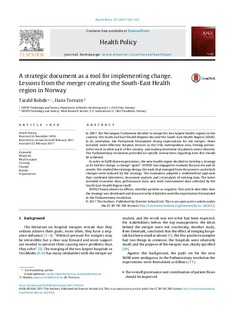| dc.contributor.author | Rohde, Tarald | |
| dc.contributor.author | Torvatn, Hans Yngvar | |
| dc.date.accessioned | 2019-02-21T13:40:53Z | |
| dc.date.available | 2019-02-21T13:40:53Z | |
| dc.date.created | 2017-04-21T15:31:15Z | |
| dc.date.issued | 2017 | |
| dc.identifier.citation | Health Policy. 2017, 121 (5), 525-533. | nb_NO |
| dc.identifier.issn | 0168-8510 | |
| dc.identifier.uri | http://hdl.handle.net/11250/2586812 | |
| dc.description.abstract | In 2007, the Norwegian Parliament decided to merge the two largest health regions in the country: the South and East Health Regions became the South-East Health Region (SEHR). In its resolution, the Parliament formulated strong expectations for the merger: these included more effective hospital services in the Oslo metropolitan area, freeing personnel to work in other parts of the country, and making treatment of patients more coherent. The Parliamentary resolution provided no specific instructions regarding how this should be achieved. In order to fulfil these expectations, the new health region decided to develop a strategy as its tool for change; a change “agent”. SINTEF was engaged to evaluate the process and its results. We studied the strategy design, the tools that emerged from the process, and which changes were induced by the strategy. The evaluation adopted a multimethod approach that combined interviews, document analysis and (re)analysis of existing data. The latter included economic data, performance data, and work environment data collected by the South-East Health Region itself. SINTEF found almost no effects, whether positive or negative. This article describes how the strategy was developed and discusses why it failed to meet the expectations formulated in the Parliamentary resolution. | nb_NO |
| dc.language.iso | eng | nb_NO |
| dc.rights | Attribution-NonCommercial-NoDerivatives 4.0 Internasjonal | * |
| dc.rights.uri | http://creativecommons.org/licenses/by-nc-nd/4.0/deed.no | * |
| dc.title | A strategic document as a tool for implementing change. Lessons from the merger creating the South-East Health region in Norway | nb_NO |
| dc.type | Journal article | nb_NO |
| dc.type | Peer reviewed | nb_NO |
| dc.description.version | publishedVersion | nb_NO |
| dc.source.pagenumber | 525-533 | nb_NO |
| dc.source.volume | 121 | nb_NO |
| dc.source.journal | Health Policy | nb_NO |
| dc.source.issue | 5 | nb_NO |
| dc.identifier.doi | 10.1016/j.healthpol.2017.02.014 | |
| dc.identifier.cristin | 1465990 | |
| cristin.unitcode | 7401,60,25,0 | |
| cristin.unitcode | 7401,60,55,0 | |
| cristin.unitname | Helse | |
| cristin.unitname | Teknologiledelse | |
| cristin.ispublished | true | |
| cristin.fulltext | original | |
| cristin.qualitycode | 1 | |

